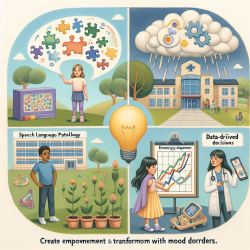The study utilized distributional semantics methods applied to a large corpus of text-based online therapy sessions, creating novel BA-related categories for the Linguistic Inquiry and Word Count (LIWC) software package. Analyzing the language used by 10,000 patients, the researchers found strong associations between linguistic indicators of activation and depression scores.
Key Findings
- Emotional tone, pronoun rates, and words related to sadness, health, and biology were complementary in explaining variance in depression scores.
- Higher levels of behavioral activation (BA) were associated with lower depression levels.
- Linguistic markers of BA, such as planning and participation in enjoyable activities, correlated with longitudinal patient trajectories.
These findings underscore the importance of using language as an indicator of mental state and the potential for automated tools to enhance therapeutic outcomes. Here are some practical ways to implement these insights in online therapy for children:
Implementing BA in Online Therapy for Children
1. Monitor Linguistic Indicators
Use LIWC or similar software to analyze children's language during therapy sessions. Look for markers such as emotional tone, pronoun usage, and words related to sadness, health, and biology. These indicators can provide real-time insights into the child's mental state and help tailor interventions accordingly.
2. Encourage Rewarding Activities
Incorporate activities that children find meaningful and rewarding into their therapy plans. Encourage them to talk about these activities during sessions, as discussing enjoyable experiences can increase their behavioral activation levels.
3. Focus on Planning and Structure
Help children set achievable goals and create structured plans to accomplish them. The study found that linguistic markers related to planning and structure were strongly associated with positive outcomes. This approach can instill a sense of accomplishment and further reduce depressive symptoms.
4. Tailor Interventions Based on Linguistic Data
Use the linguistic data collected to customize interventions. For example, if a child frequently uses first-person singular pronouns, it may indicate increased self-focused attention, a common marker of depression. Tailoring interventions to address this can be more effective.
Encouraging Further Research
The study opens the door for further research into automated diagnosis and assessment of depression, particularly in children. By continuously refining BA psychotherapeutic strategies and developing predictive models, we can improve the effectiveness of online therapy services.
To read the original research paper, please follow this link: Behavioral Activation and Depression Symptomatology: Longitudinal Assessment of Linguistic Indicators in Text-Based Therapy Sessions










